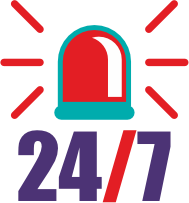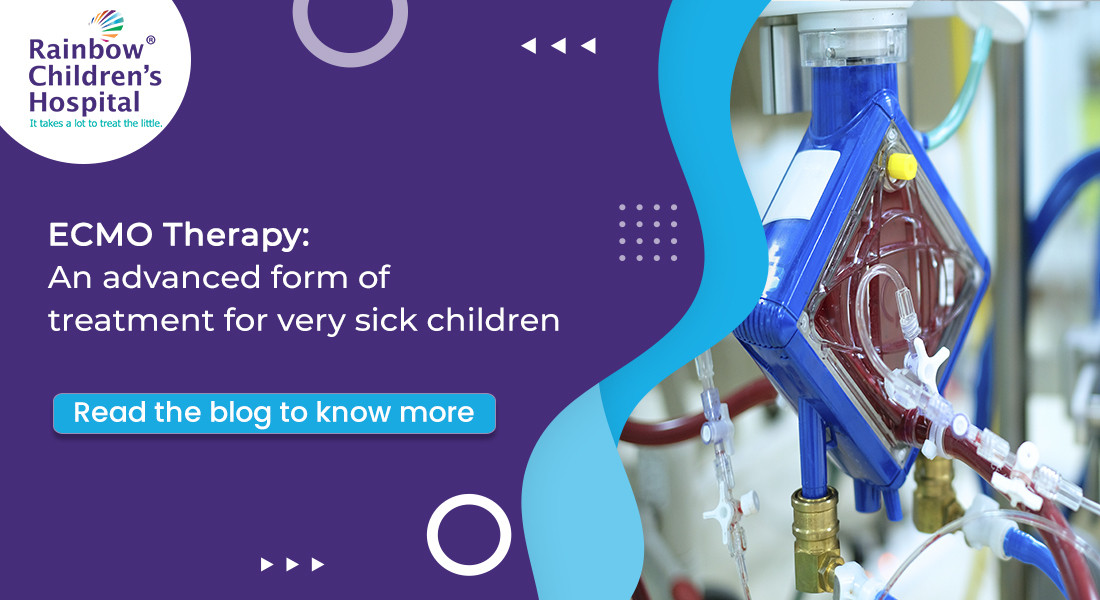Categories
ECMO Therapy: An Advanced Form of Treatment For Very Sick Children
Oct 28, 2022
Two-year-old Arjun was alright till 4 days ago when he developed a mild fever accompanied by cough and cold. The parents took him to a nearby pediatrician and started him on routine medications for the symptoms. However, his breathing difficulty worsened and he required hospitalisation. He was diagnosed with H1N1 pneumonia (Swine Flu) and connected to mechanical ventilation (device to support breathing). He could not be stabilised on ventilator, and required very high pressures and oxygen concentrations. The family was counselled about the need of shifting the child to a centre where ECMO therapy could be provided to save the child’s life.
ECMO is a specialised modality of therapy. If used appropriately, it carries a lot of promise in the management of sick children.
So here are some frequently asked questions and answers about ECMO therapy.
What is ECMO?
ECMO stands for Extracorporeal Membrane Oxygenation.
• Extracorporeal: outside the body
• Membrane: a type of artificial lung
• Oxygenation: the process of getting oxygen into the blood
It is a method of providing oxygen to the body when the lungs and/or heart are not able to supply oxygen on their own. With ECMO, blood leaves through a catheter that sits in a large vein and connects to an oxygenator machine. The blood then returns to the body through an artery or vein, using a different catheter.
There are two types of ECMO.
Veno-venous (V-V) ECMO is used when the heart is functioning well and only the lungs need to rest and heal.
Veno-arterial (V-A) ECMO is used when both the heart and the lungs need to rest and heal.
Why does a child get placed on ECMO?
ECMO can help infants and children with a variety of medical problems and conditions, including:
• Acute Respiratory distress syndrome (ARDS): a lung condition that makes it difficult for children to breathe on their own.
• Severe Pneumonia (H1N1 or other viral and bacterial pneumonias)
• Congenital heart conditions (Birth defects in the heart)
• Sepsis (Severe infection in the bloodstream)
• End-stage cardiac or respiratory failure (as a bridge to transplant)
What is the difference between ECMO and mechanical ventilator (breathing machine)?
Both ECMO and mechanical ventilator aim to provide oxygen to the body when the patient’s lungs are failing. We almost always try oxygenating a patient with a ventilator first. However, when a patient’s lungs are too sick for this, we turn to ECMO to assist in providing oxygen to the body. A mechanical ventilator assists the patient’s lungs by pushing oxygen into the lungs with pressure, whereas ECMO provides oxygen directly via a catheter placed in a patient’s vein or artery.
V-V ECMO provides oxygen through a vein. This blood then has to travel to the heart and be pumped around the rest of the body through arteries. Therefore, with V-V ECMO or a ventilator, a patient must have a well-functioning heart to get the oxygen pumped throughout the body. V-A ECMO has the additional advantage of pumping blood directly to arteries. This “by-passes” the heart and is therefore the method of ECMO we use when a patient’s heart is failing. It is not used routinely because there are greater side effects with V-A ECMO.
ECMO Team
To help ensure the best outcomes, it's important to choose an experienced and qualified ECMO team with rigorous training in this complex level of life support.
While your child is on ECMO, he/she will be taken care of by a team of Paediatric intensivists, cardiologists, perfusionists, nurses, cardiac surgeons, and other specialists.
There should always be a well-trained nurse and an ECMO specialist at your child’s bedside.
They should constantly monitor vital signs and comfort, perform care and maintain the ECMO circuit. An “in-house ECMO specialist perfusionist” should be available as a resource to the staff 24/7.
A team of doctors will make rounds (visit the bedside) every morning, assess the progress of your child, and share that information with you. Doctors will also check on your child throughout the day.
What to expect when a child is on ECMO therapy?
Even though ECMO replaces the functions of lungs and allows them to rest, your child will remain on a mechanical ventilator to deliver controlled amounts of pressure and oxygen to his/her lungs at lower rates. The sedation medications will make your child sleep comfortably during the ECMO. Even though your child is sleeping, you can talk to and carefully touch him/her. As it is important to let your baby rest while on ECMO, the ECMO specialist can guide you when it is safe for your baby to be stimulated.
What are the side effects of ECMO?
Whenever large catheters are placed in patient’s veins and arteries, there is always a risk of bleeding and infection. Large catheters also have a risk of causing clots. To avoid clot formation, all patients on ECMO are placed on blood thinning medication called Heparin. This further increases the risk of bleeding.
What daily tests need to be done for someone on ECMO?
Patients on ECMO are constantly monitored. They require continuous monitoring of their vital signs, including their blood pressure and oxygen levels. In addition, they require blood tests each day since normal blood counts are essential for ECMO to work best.
Tests are required to check your baby’s blood so we can adjust anticoagulant medications (“blood thinners” such as Heparin) during ECMO support and haemoglobin/hematocrit levels in the blood. Each day a patient should have a neurologic exam to check he/she has enough oxygen delivery to the brain. Arms and legs must be examined to check whether oxygen is reaching all four limbs and that there have been no complications from a catheter insertion. Imaging tests are done at bedside to monitor the patient’s progress, including X-rays to check the location of the cannulas and monitor inflation of the lungs, ultrasound of the head to monitor complications related to bleeding, electroencephalogram (EEG) to monitor brain activity, and echocardiogram (an ultrasound of the heart) to assess how the heart is doing as we attempt to wean your baby from ECMO support.
How long can someone stay on ECMO?
Duration of ECMO therapy is very variable, depending on many factors. Due to the risks of ECMO discussed above, doctors try to keep patients on ECMO for as short a time as possible. Often patients will be on ECMO for several days up to 1-2 weeks. Every day, several blood and imaging tests are done to determine if a patient is ready to be taken off ECMO.
Post ECMO
Immediately following removal of the cannulas and ECMO circuit, your child will need to remain on a ventilator to maintain oxygenation. Nitric oxide is a gas given through the ventilator to relax blood vessels. Over time, the goal is to wean your child slowly from the ventilator and medications. A nurse will continue to closely monitor vital signs of pain, and perform ordered lab work. While each child is different, be prepared that your child’s recovery period from ECMO may be measured in weeks and months rather than in days.







